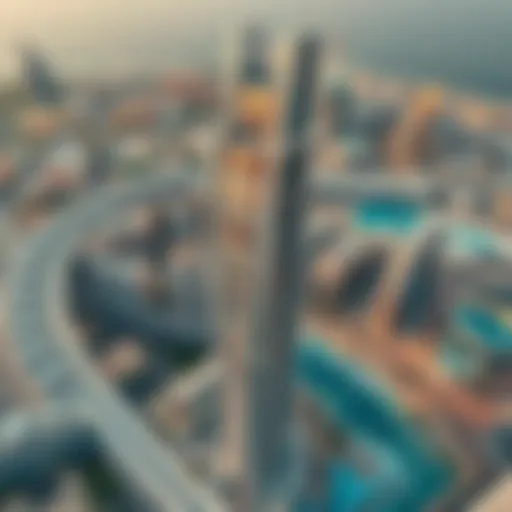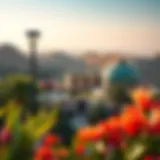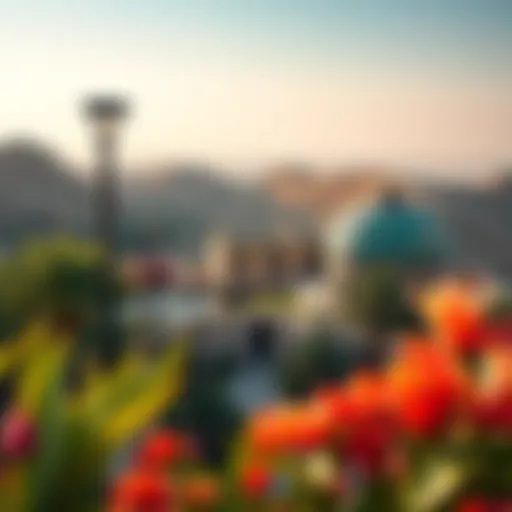Architectural Wonders of the UAE: A Journey Through Time
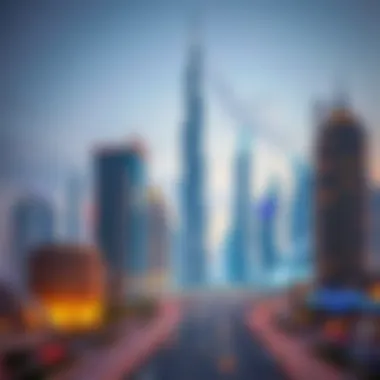
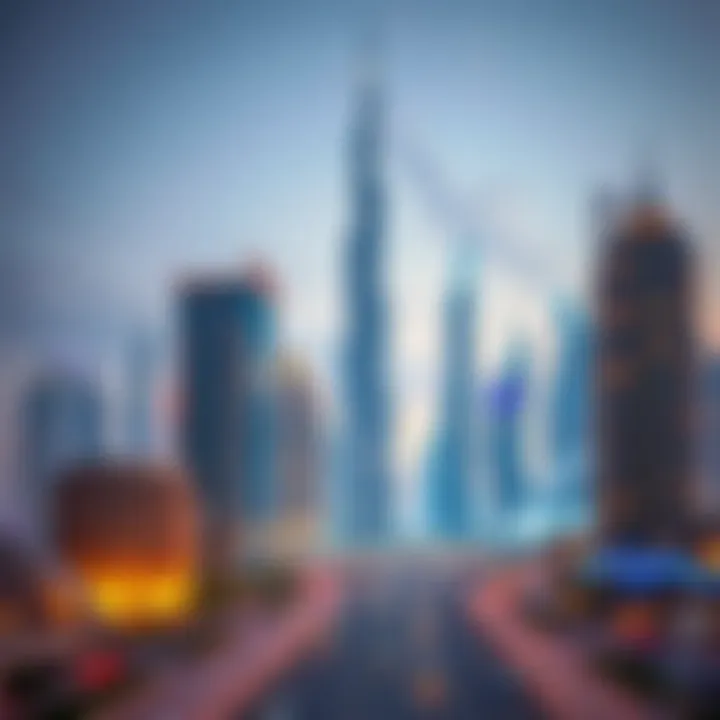
Intro
The architectural development of the United Arab Emirates, particularly in Dubai, is more than a mere showcase of stunning designs; it’s a narrative woven through time that reflects the country’s rapid transformation and ambition. From humble beginnings, where structures were predominantly made of clay and palm fronds, Dubai now boasts iconic skyscrapers that reach towards the skies, symbolizing not just wealth but a vision that draws eyes worldwide. As we explore this transformation, it is essential to dissect the various elements that influence the architectural landscape today.
In this article, we aim to take readers on a journey through several critical aspects that define UAE's architectural identity. We will delve into the key architectural styles that have emerged over the years, assess the impact of cultural influences, and look closely at future trends that promise to shape the skyline of tomorrow.
Understanding the nuances of real estate trends, property types, and emerging markets can provide valuable insights for investors and real estate enthusiasts exploring opportunities within this dynamic environment. By breaking down each segment, we provide a comprehensive lens through which one can evaluate the architectural marvels of the UAE. Let’s embark on this exploration of the buildings that express the vision, culture, and economic vitality of this incredible region.
Foreword to UAE Architecture
The architectural landscape of the United Arab Emirates is a tapestry interwoven with threads of rich cultural heritage, modern innovation, and ambition. This introduction to UAE architecture sets the stage for understanding how buildings are not merely functional structures but rather reflections of the society, economy, and aspirations of their time. Every high-rise, every sprawling villa, and every cultural landmark plays a part in narrating the story of a rapidly evolving nation.
In recent decades, the UAE has witnessed an architectural renaissance driven by globalization and a burgeoning economy. This significantly influences the design philosophy and construction techniques employed here. Moreover, the emirates are home to more than just eye-catching skyscrapers; they showcase a blend of tradition and modernity, where ancient design principles meet contemporary aesthetics.
Cultural Significance
The architecture in the UAE carries immense cultural significance, serving as a physical embodiment of both its past and future. Buildings like the Sheikh Zayed Grand Mosque symbolize not only the Islamic faith but also the country's commitment to cultural inclusivity. Their design elements encapsulate traditional Islamic art, often characterized by intricate detailing and grand scale. This architectural style is not just for show; it resonates deeply with the values and identity of the Emirati people.
There’s also a narrative of unity that flows through the designs of various structures. For instance, the recently opened Museum of the Future showcases innovation while drawing from Islamic architectural motifs, creating a bridge between cultural heritage and modern ideas. The unique blend of styles reflects the UAE’s multi-cultural society, where a medley of influences can be seen in the buildings that dot the skyline.
"Architecture is the art of how to waste space." - Philip Johnson
This quote resonates when considering how incorporating cultural elements in design often leads to more functional yet aesthetically rich spaces, ensuring that every corner of these structures reflects the community’s spirit.
Historical Context
To better understand contemporary architecture in the UAE, it is vital to appreciate its historical context. The rapid urbanization that began in the mid-20th century transformed the face of the emirates. Prior to this transformation, the region’s architectural style primarily revolved around traditional Arabian fortresses and inland settlements, built using mud and palm fronds. These structures were practical for the climate but did little to prepare for what was to come.
The discovery of oil in the 1950s acted as a catalyst for innovation. Resources poured into the development of urban centers, leading to the construction of iconic buildings that not only marked a shift in architectural style but also encapsulated an era of economic prosperity and international collaboration.
As a result, the architectural evolution can be categorized into several phases. Initially, buildings were designed primarily for utility. However, as the economy flourished and global interaction increased, architects began to embrace bold, experimental designs. This transition paved the way for globally recognized icons such as The Burj Khalifa and the Abu Dhabi National Exhibition Centre, each designed with forward-thinking principles that challenge conventional architecture.
Understanding this historical framework allows investors, homebuyers, agents, and developers to appreciate the context of their investments and the significance of architectural styles when navigating the real estate market. Each building is not simply constructed; it is an investment in the future, carefully curated to reflect the evolving identity of the UAE.
Key Architectural Styles in the UAE
The architectural styles present in the UAE are more than just mere aesthetics; they speak to the region's rich cultural tapestry and evolving economic landscape. Understanding these styles is crucial for recognizing how buildings in the UAE encapsulate both tradition and modernity. The structural designs mirror the heritage while marrying contemporary needs. Investors and homebuyers should consider these architectural styles not only as a matter of personal preference but also as pivotal factors affecting property value and community identity.
Islamic Architecture
Islamic architecture has left a strong mark on the UAE, serving as a forward reflection of the Arab world’s historical roots. Characterized by intricate geometric patterns, towering minarets, and expansive courtyards, Islamic architecture is a delicate balance of functionality and beauty. The use of traditional materials like adobe and stone, combined with modern innovations, results in stunning constructions that are both sustainable and culturally significant.
This architectural style emphasizes symmetry and grandiosity, often seen in mosques and community buildings. For instance, the Sheikh Zayed Grand Mosque in Abu Dhabi embodies these principles, standing as a monument that attracts visitors from all corners of the globe. Its domes and columns create a narrative linking the past with the present, making Islamic architecture pivotal in understanding the UAE’s identity.
Contemporary Designs
Modern architecture is like a dance between glass and steel, embodying boldness and creativity. This style has revolutionized the skyline, injecting Dubai with a sense of futuristic appeal. The marriage of different materials results in innovative structures that challenge traditional building norms.
Glass and Steel Structures
The rise of glass and steel in architecture marks a significant interest in transparency and luminosity. These structures are noted for their clean lines and minimalist aesthetic. Such designs not only allow natural light to flood interiors but also help in energy efficiency by reducing the need for artificial lighting during the day. For real estate investors and potential homeowners, the appeal of glass and steel structures lies in their modern flair and high-tech amenities, making them popular choices in luxury developments.
However, they come with their own set of challenges. Temperature control can be tricky, demanding advanced climate management systems to ensure comfort. Still, the allure of these modern marvels, with their striking silhouettes against the desert backdrop, remains powerful.
Parametric Design

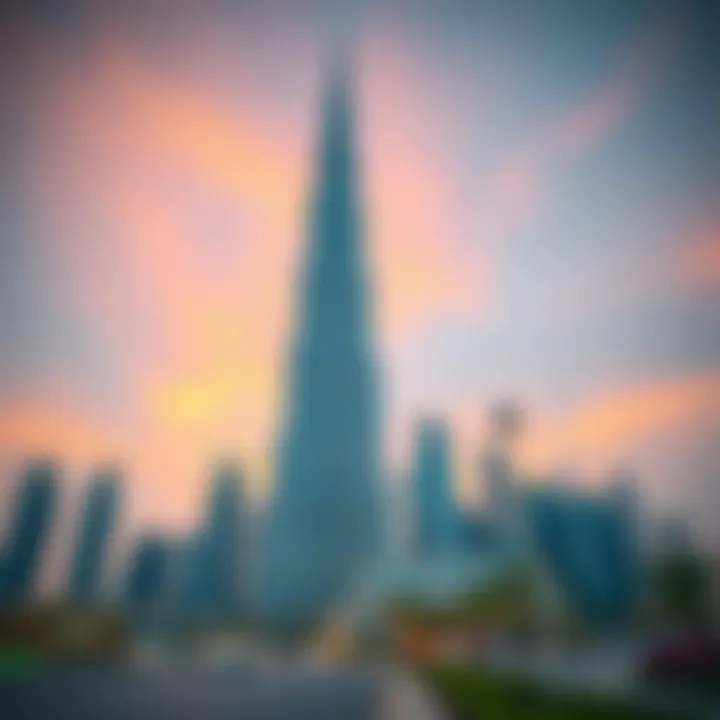
Parametric design is another cutting-edge approach that has gained traction in UAE's architecture. This method utilizes advanced algorithms to produce complex shapes and forms, pushing the boundaries of traditional building. The adaptability and creative potential of parametric design make it a boon for architects aiming to create bespoke, site-specific structures.
A key characteristic is that it embraces change; designs can evolve based on various parameters, such as environmental factors or user feedback. This flexibility is especially beneficial in a rapidly growing market like Dubai. Yet, it’s important to note that while the initial design phase may show immense promise, the construction may face complications due to the intricate features involved.
Sustainable Architecture
Sustainability has become a vital consideration, as the UAE grapples with its rapid urbanization. This architectural style fosters a harmonious relationship between nature and built environments, often reflecting local ecosystems.
Green Building Initiatives
Green building initiatives are at the forefront of sustainable architecture in the UAE. They aim to minimize the environmental impact of constructing and operating buildings. These initiatives often focus on energy conservation, water efficiency, and sustainable materials to create healthier living environments. This is significant in the arid climate of the UAE, where resource consumption must be carefully managed.
Distinctive features of these projects include green roofs, solar panels, and rainwater harvesting systems. For homeowners and investors, supporting green initiatives can elevate a building's value while promoting a responsible lifestyle. However, implementing such features involves initial expenses that might deter some investors, despite the long-term cost savings and environmental benefits.
LEED Certification
LEED certification represents a benchmark for sustainability in architecture. This internationally recognized system offers a framework for developing healthy, efficient, and cost-saving buildings. It evaluates criteria such as energy use, water efficiency, and indoor environmental quality.
The benefit of achieving LEED certification lies in its appeal to a growing demographic of environmentally-conscious buyers. It can enhance marketability and investment potential for developments, appealing to those prioritizing sustainable living. Nonetheless, the certification process can be complex and time-consuming, which may discourage some developers from pursuing it.
In summary, the architectural styles of the UAE embody the intricate dance of history, culture, and innovation. By understanding these diverse elements—from Islamic architecture to contemporary and sustainable designs—investors and prospective homeowners can navigate the UAE real estate market with greater insight.
Iconic Structures of the UAE
When one thinks of the UAE, the mind often races to spectacular buildings that punctuate its skyline. These iconic structures are not just visually stunning; they represent the UAE's rapid evolution in design and construction. Serving as symbols of progress, each building tells a story of cultural heritage, economic aspirations, and architectural ingenuity. Understanding the significance of these marvels provides insight into how the UAE has carved a niche for itself on the global stage.
Burj Khalifa
Design and Engineering
The Burj Khalifa stands tall as a testament to human endeavor in structural engineering. At 828 meters, it's the tallest building in the world, and its design was not just about height; it embraced local culture and climate. The Yas Island Development had its hand in ensuring that the tower remains resilient against the region's heat and wind. The unique pattern of its facade resembles a native desert plant, which is both an aesthetic choice and a practical one, allowing for better airflow. This harmony between design and environmental sensitivity is what makes it not just a building, but a model for future ambitious projects.
Additionally, the engineering behind the skyscraper involves a complex system of reinforced concrete and a series of innovations in elevators, enabling ultra-fast travel between its floors. The decision to utilize this technology enhances both the functional and service aspects of the tower, reaffirming why Burj Khalifa captivates both investors and tourists alike.
Impact on Tourism
The impact of the Burj Khalifa on tourism cannot be overstated. As the centerpiece of Downtown Dubai, it attracts millions of visitors each year. People flock not only to gaze upon its towering presence but also to experience the observation decks where panoramic views of the city offer an unmatched perspective. This specific attraction has turned the Burj into a thriving hub for tourism, generating substantial revenue that feeds back into the local economy.
Moreover, its role extends beyond mere visuals; it has sparked a proliferation of luxury hotels and dining establishments in the vicinity, creating a vibrant ecosystem. By establishing itself as a global landmark, the Burj Khalifa has positioned Dubai as a prime tourist destination, influencing investors to pour resources into projects that enhance and sustain this tourism-driven model.
The Louvre Abu Dhabi
Cultural Integration
The Louvre Abu Dhabi is more than just an art museum; it embodies a vision of cultural integration. The architects aimed to create a space that transcends geographic boundaries, bringing pieces from different eras and cultures under one roof. This aspect of cultural integration is vital to the UAE’s identity as a melting pot for diverse global influences. The building itself reflects this ethos—it combines traditional Arabic architectural elements with a modern approach, demonstrated by its iconic dome that reflects light in beautiful patterns across the space below.
By fostering a greater understanding between cultures, the museum encourages dialogue—a factor that is increasingly important in today’s rapidly changing world. It serves as a vital checkpoint for investors looking to enter the art sector or those seeking cultural partnerships, as its reputation elevates Abu Dhabi’s status on the international stage.
Architectural Innovations
Innovations in architecture defined the Louvre Abu Dhabi, setting a precedent for contemporary museum design. Its design not only incorporates a stunning floating dome but also pays attention to environmental context with a sustainable shading system. This unique feature protects the delicate art collections while providing a distinctive aesthetic appeal.
While architect Jean Nouvel's foresight in embedding climate responsiveness in the design is commendable, it also showcases a forward-thinking mindset vital for future constructions. Investors observing these architectural innovations appreciate the balance of beauty and functionality, making the Louvre a blueprint for transformative projects in the UAE and beyond.
Palm Jumeirah
Unique Land Reclamation
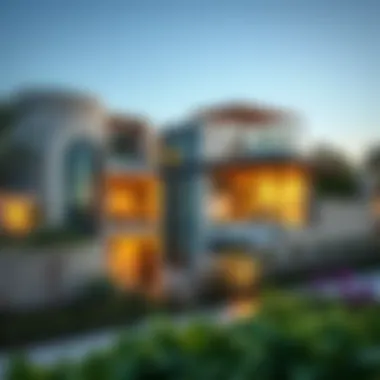

The Palm Jumeirah stands as a remarkable feat of land reclamation, demonstrating how human ingenuity can reshape the natural landscape. This engineering marvel wasn't just built for the sake of expansion; it represents an ambitious plan to create a unique vacation destination that enhances the tourism sector. With its palm tree design, it attracts attention for its innovative layout and serves as home to luxurious residences and high-end resorts.
The unique land reclamation process led to challenges such as environmental impact, which was tackled through rigorous studies and mitigation strategies. This awareness is reassuring to investors, as it shows that sustainable considerations can coexist with ambitious real estate ventures.
Luxury Real Estate Development
The focus on luxury real estate development on Palm Jumeirah spells good news for investors looking to capitalize on a growing market. The area has not only become a hotspot for high-net-worth individuals but also serves as a template for elite living. Properties here range from lavish villas to luxury apartments, each boasting spectacular views of the sea.
What sets luxury real estate on Palm Jumeirah apart is the aura of exclusivity tied with world-class amenities, creating a desirable living environment. This uniqueness attracts buyers not just for residence but also for investment purposes, making properties here a hot commodity. As the demand for high-end real estate continues to rise, Palm Jumeirah is poised to become even more relevant in future discussions about luxury living in the UAE.
Urban Development in Dubai
Urban development in Dubai is a cornerstone of its architectural landscape, playing a pivotal role in shaping not only the skyline but also the economic and social fabric of the city. The rapid growth seen in this emirate has been fueled by a complex interaction of factors, including extensive investment in infrastructure, a thirst for modern living spaces, and a commitment to innovative architectural practices. The outcome is an environment where luxury and affordability meet, creating a dynamic zone for investors, homeowners, and developers alike.
One of the critical aspects of urban development is its regulatory framework. This framework lays down the legal and operational groundwork that guides construction practices, ensuring that they align with the country’s vision for progression while preserving its cultural heritage. This alignment is not merely about aesthetics; it is significant for sustainability and economic viability in the long run.
Regulatory Frameworks
The regulatory frameworks governing urban development in Dubai are highly sophisticated and designed to create a balance between growth and sustainability. They encompass a wide range of policies that allow for cohesive development across different sectors. Key policies include the Dubai Land Department Regulations and the Dubai Urban Master Plan, which outline zoning laws, building codes, and standards for construction.
These frameworks serve multiple purposes:
- Ensure Quality and Safety: Regular inspections and compliance checks guarantee structural integrity and safety, which benefits residents and investors.
- Promote Sustainable Practices: Regulations encourage the use of sustainable technologies and materials, aligning with global practices aimed at minimizing environmental impact.
- Facilitate Economic Growth: By streamlining processes for obtaining permits, the frameworks make it easier for new businesses and residential projects to launch, thus boosting the economy.
Market Trends
As Dubai forges ahead, market trends illustrate the shifting priorities of residents and investors. Two notable trends are the rising demand for luxury properties and a notable shift towards affordable housing. Both trends reveal insights into the evolving needs and preferences of the population.
Rising Demand for Luxury Properties
The appeal for luxury properties in Dubai is not just a passing phase; it reflects deeper societal values and aspirations. High-net-worth individuals are especially drawn to properties that offer exclusivity, modern amenities, and proximity to key facilities, such as elite schools and business districts. One significant characteristic of luxury properties is their unique architectural designs. Often, these buildings are crafted by world-renowned architects and are not merely residences but landmarks.
Among the advantages are:
- Potential for High Returns: Luxury real estate often appreciates significantly over time, attracting investors looking for long-term gains.
- Enhanced Lifestyle Offerings: These properties typically come with a suite of amenities, such as concierge services, private pools, and health facilities that provide a high-quality living experience.
However, there are downsides to this trend. Prestige comes with a hefty price tag that might not be accessible to all. This has led to calls for diversifying the housing market to cater to all income brackets.
Shift Towards Affordable Housing
In contrast, the shift towards affordable housing addresses pressing needs for mid-income families. This trend has garnered attention due to rising living costs in urban centers, making it essential for urban planners and developers to prioritize affordable options. One key characteristic of affordable housing is its focus on practical design that maximizes space without compromising comfort or style.
The benefits include:
- Enhanced Accessibility: More homes can be cultivated for individuals and families who might otherwise struggle to find decent housing.
- Community Growth: An influx of affordable housing can foster integration within communities, developing vibrant social dynamics and economic opportunities.
However, developers face challenges in maintaining quality while ensuring affordability, making this a delicate balancing act.
Urban development in Dubai encapsulates a broad narrative beyond just construction; it is about creating a holistic environment where various housing types coexist, reflecting the changing demands and cultural aspirations of a diverse populace. Effective regulatory frameworks and evolving market trends illustrate how Dubai is navigating these waters. By understanding these elements, stakeholders can better strategize and innovate, paving the way for a thriving architectural landscape.
Building Technologies and Innovations
The world of architecture is constantly evolving, and the United Arab Emirates stands as a prime example of how building technologies and innovations shape the skyline of its cities. This section delves into the essential elements of building technologies, highlighting how they not only enhance aesthetics but also improve functionality and efficiency. For investors and homebuyers alike, understanding these technological advancements is crucial for making informed real estate choices in a rapidly changing market.
Smart Building Integration
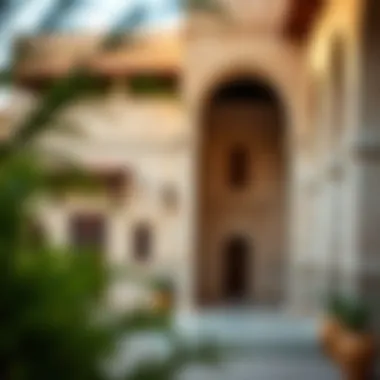

Smart buildings represent a significant leap forward in the way structures interact with their inhabitants. These systems utilize sensors and AI to streamline operations, managing heating, lighting, and security with remarkable precision.
- Energy Efficiency: By adopting smart technologies, buildings can dramatically reduce energy consumption. For instance, smart thermostats learn the patterns of occupants, adjusting temperatures accordingly and thus decreasing unnecessary energy use.
- Enhanced Security: Advanced security systems incorporate surveillance cameras and smart locks that can be controlled remotely, ensuring that homeowners always have their property under watch, no matter where they are.
- User Experience: The integration of smart technologies leads to a seamless experience for residents and visitors alike. Automated lighting and climate controls can create a more comfortable atmosphere that adjusts to the needs of those within the building.
"With smart building technologies, we're not just constructing spaces; we're creating environments that react to human needs."
However, while smart building integration presents numerous advantages, potential investors and homeowners must consider the initial costs of implementing such technology. As the market develops, the long-term savings presented by these systems often outweigh the upfront expenses, making them a worthwhile investment in the long run.
3D Printing in Construction
The adoption of 3D printing in construction is revolutionizing how structures are designed and built. This technology offers the potential for notable reductions in time and waste, making it an alluring solution for developers looking to maximize efficiency.
- Speed of Construction: When utilizing 3D printing for building components, construction times can be significantly shortened. What might take traditional methods several weeks or months can often be accomplished in mere days.
- Cost Effectiveness: Reducing waste is a critical factor in any construction project. 3D printing allows for precise material usage, leading to less waste and therefore lower costs attached to the entire construction process.
- Design Flexibility: This technology allows for intricate designs that may be difficult or even impossible to achieve through conventional building methods. Architects can push the boundaries of creativity, resulting in unique structures that capture attention.
Although 3D printing stands out as a cutting-edge technology, stakeholders should remain aware of the regulations and standards that accompany its use. Establishing a solid understanding of local building codes and ensuring compliance is necessary for moving forward with this innovative approach.
In summary, both smart building integration and 3D printing are reshaping the architectural landscape of the UAE. As the building industry continues to embrace these innovations, they open up new avenues for development, offering not just enhanced living environments but also robust solutions to modern challenges.
Future Trends in UAE Construction
As the UAE continues to position itself as a center of innovation and growth, the construction industry evolves to embrace new methodologies and ideas that cater to its ambitious vision. The significance of delving into future trends in UAE construction cannot be overstated, as these developments dictate the economic momentum, sustainability protocols, and overall livability of the UAE, making it essential for investors and stakeholders to stay ahead of the curve.
Sustainable Urban Planning
Sustainable urban planning is more than just a buzzword; it’s becoming a non-negotiable aspect of construction in the UAE. The government emphasizes creating spaces that endure both economically and environmentally. This emphasis aligns with the nation’s development goals, particularly diversifying its economy and reducing reliance on oil.
One major aspect of sustainable urban planning is the integration of green spaces throughout urban areas. Many new projects aim to offer parks, gardens, and recreational areas, providing residents with a much-needed respite from the bustling city life. These spaces are intentionally designed to encourage community interaction, improving the quality of life for inhabitants.
Urban planners are also focusing on minimizing the urban heat island effect by incorporating reflective materials and greenery in building designs. By using solar panels and energy-efficient systems, developers not only cut down on costs in the long run but also help meet regulatory requirements focused on reducing carbon footprints.
Moreover, some key elements of sustainable urban planning include:
- Mixed-use developments to foster community engagement.
- Active transportation corridors encouraging walking and cycling.
- Smart Water Management Systems to reduce waste.
Impact of Technology
The role of technology in shaping the future of UAE construction cannot be underestimated. With the rapid advancements in construction methods and tools, the way structures are designed, built, and maintained is evolving swiftly. From smart buildings to digital twins, the landscape of construction is undergoing a transformation.
One of the most exciting technologies making its mark is Building Information Modeling (BIM). This intelligent model-based process fosters collaboration among different stakeholders, providing a clearer picture at every stage of development. With BIM, potential drawbacks can be identified and addressed before they escalate, resulting in significant cost savings and time efficiency during the construction phase.
Drones are also becoming an inherent part of project management, allowing for real-time monitoring and assessment of construction sites. They can gather data that supports precise planning and tracking of progress, enhancing both speed and safety on-site. Furthermore, automation and robotics are beginning to revolutionize certain aspects of construction, from prefabrication to material handling, leading to fewer human errors and increased productivity.
Finally, the integration of Internet of Things (IoT) devices enhances building operations by providing real-time data about energy consumption, air quality, and security. For instance, smart sensors help maintain optimal temperature settings while minimizing energy spikes.
These technologies not only improve efficiency but also align with sustainability efforts by ensuring buildings are used effectively. As we look ahead, the influence of technology on construction practices will undoubtedly emerge as a pivotal factor in optimizing the overall developmental strategy within the UAE construction sector.
Ending
The architectural evolution within the United Arab Emirates, particularly in Dubai, has not only transformed the skyline but also serves as a mirror reflecting cultural, economic, and social values. This article provides a comprehensive examination of various aspects that shape UAE architecture, highlighting how these structures embody the region's ambitions and identity.
Summary of Key Points
In summarizing the discussion, three major points stand out:
- Cultural Resonance: UAE's architectural designs are deeply rooted in Islamic traditions while also embracing modernity. Buildings like the Louvre Abu Dhabi illustrate a blend of cultural narratives.
- Technological Advancements: Innovations such as smart building integration and 3D printing have revolutionized construction, making it faster, more efficient, and adaptable.
- Environmental Considerations: An increasing focus on sustainable architecture reflects a commitment to environmental stewardship, seen in the push for green building initiatives and LEED certifications.
Implications for Investors and Homeowners
For investors and homeowners eyeing opportunities in the UAE real estate market, understanding these architectural trends is crucial. The growth in luxury properties indicates a lucrative market but also highlights a shift towards affordable housing options.
Investors should consider the implications of zoning laws and regulatory frameworks that impact property values and market demand. Homebuyers must be aware of how architectural innovations can enhance living experiences and long-term investments. Engaging with real estate professionals who have a nuanced understanding of these dynamics is advisable.
"The innovations in architecture and building technologies in the UAE are steering us toward a future that's not just about space but about experiences."



